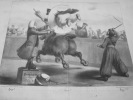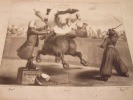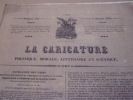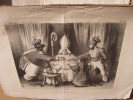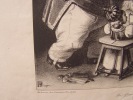4 books for « roubaud benjamin dit... »Edit
Traites de la quadruple alliance... Resurrection de don Carlos ....Lithographie.
1834 La Caricature. Journal. Morale, Religieuse, Littéraire, Scénique- La Caricature ( Journal) No 196, plate 411 [Paris] Delaunois for Maison Aubert [7 August 1834] Lithograph. Platemark 32 × 27cm; overall paper size 36.3 × 27.6 cm.,rare,bon étatFrench caricature of the Quadruple Alliance between France, Great Britain, Spain, and Portugal signed on 22nd April 1834 which crowned Talleyrand’s diplomatic career. The treaty, conceived by Palmerston to strengthen the liberal countries of western Europe against the auto- cratic northern monarchies, supported progressive governments recently installed in Spain and Portugal, against the claims of rival pretenders to the throne representing traditional interests. The infant Queen Isabella II of Spain1 was challenged by her uncle Don Carlos,2 and the young Queen Maria II of Portugal3 by her uncle Dom Miguel.4 The print shows Talleyrand peacefully reclining on a monument, as the architect of the treaty with pandemonium surrounding him. In apseudo-resurrection scene Don Carlos is shown flying on high shed- ding proclamations causing an explosion on the stock exchange, whilst below, the Queen Regent of Spain with her daughter Isabella, King Louis-Philippe and two other princes are looking up in a daze. Military conflict is indicated in a dark, brooding background.1 Isabella II of Spain (1830–1868), daughter of Ferdinand VII and Maria Cristina of the Two Sicilies, succeeded to the throne, because her father induced the Cortes to set aside the Salic law to re-establish the ancient law of succession. This was contested by her uncle, the Infante Carlos, who fought a civil war to support his claim with the help of the conservative opposition;2 Carlos Maria Isidro de Borbony Borbon-Parma(1788–1855),younger brother of King Ferdinand VII, known as Count of Molina, claimed the throne of Spain according to Salic law which excluded female succession introduced during the 18th century; the law was changed by Ferdinand in favour of his daughter Isabella. As a result the country was rent by civil war between the incumbent regency supported by the liberals and the Carlist pretender backed by the traditionalists;3 Dona Maria II (1819–1853), daughter of Pedro I Emperor of Brazil, became Queen Regnant of Portugal, when her liberal father abdicated the Portuguese throne. The decision was disputed by her absolutist uncle Miguel who usurped the throne, but was forced to abdicate in 1834;4 Dom Miguel(1802–1866),secondsonofKingJoaoofPortugal,aconserva- tive influenced by Metternich, led two revolts against his liberal father, and was exiled as a consequence. After betrothal to his young niece Maria II of Portugal, he took sole power and ruled as Miguel I of Portugal from 1828 to 1834, overthrowing the liberal constitution. In 1831 his elder brother Pedro abdicated the throne of Brazil, and ejected Miguel after a three-year civil war to re-establish Maria as Queen Regnant in 1834.
Remise de 20% pour toutes commandes égales ou supérieures à 100 €
Cet enfant la ne marchera jamais seul.Lithographie en couleur.
1833 Planche HT parue dans La Caricature politique, morale, littéraire et scénique, volume 6, 29 août 1833 (Planche n°308)- La Caricature. Journal. Morale, Religieuse, Littéraire, Scénique - La Caricature ( Journal) No 147.coloriée. Plate 308. [Paris de Becquet for Maison Aubert [29 August 1833] Lithograph. Overall paper size 34.5 × 25.8 cm.French caricature of Talleyrand’s proposal to Lord Palmerston to form an alliance with Britain to counter-balance the continental league of the autocratic states of Russia, Austria, and Prussia.The print represents Talleyrand standing, supported on a crutch, reining in the infant Louis-Philippe, whilst King William IV bemus- edly looks on, commenting: ‘this child will never walk alone’. One rein is marked ‘Traite de 1815’, the other ‘Sainte Alliance’. Louis- Philippe is depicted from behind as a small boy in skirts playing with a miniature fortress and pulling a toy cannon. As usual with this artist, Talleyrand’s surgical boot is attached in error to his left foot.1 Benjamin Roubaud (1811–1847), lithographer, etcher and painter, made his name as an inspired Parisian caricaturist, contributing to the humorous comic journal La Caricature (1830–1835); he signed himself ‘Benjamin’or ‘A.B.’Dwyer 762 (misdated 1834).
signature : « Benjamin et Paillet » [Benjamin Roubaud, dessinateur, et Paillet, graveur]- Inscription - Sur le château de sable, un graffiti en forme de poire ; sur les laisses avec lesquelles Talleyrand tient le roi : « Traités de 1815 » et « Sainte alliance »Description iconographique:Talleyrand, à dte de la composition, vu de profil, appuie son bras gche sur une béquille. Il tient en laisse un enfant vêtu d’une robe rose et d’un petit fichu bleu (« en moutard tricolore » in explication). Vu de dos, il est reconnaissable au toupet et aux favoris : il s’agit du roi Louis-Philippe, occupé à construire un château de sable avec une truelle. Il tient en laisse un petit canon posé sur une plate-forme à roulettes. Allusion à son désir d’édifier des forts autour de Paris. Derrière eux se trouve Guillaume IV, roi du Royaume-Uni. Il montre Louis-Philippe du doigt tout en regardant Talleyrand avec un sourire moqueur. Il semble donner des ordres à Talleyrand. Cette pl. est une référence au projet de rapprochement avec l’Angleterre tenté par Talleyrand en direction de Palmerston pour contrer l’alliance continentale de la Russie, l’Autriche et la Prusse (Sainte-Alliance de 1815 entre ces trois pays, puis rejointe par la France en 1818 grâce à l’action de Talleyrand). Or, Guillaume IV s’y opposa, fervent défenseur de l’isolationnisme (le Royaume-Uni avait déjà refusé, en 1818, d’entrer dans la Sainte-Alliance). La pl. se moque du manque d’autonomie et d’autorité de Louis-Philippe sur l’échiquier européen.Personnages représentés:Talleyrand-Périgord, Charles-Maurice de; Louis-Philippe Ier, roi des Français Remise de 20% pour toutes commandes égales ou supérieures à 100 €
Roubaud, Benjamin (dit Benjamin) (Roquevaire, 01–06–1811 - Alger, 14–01–1847), dessinateur lithographe - TALLEYRAND
Reference : 25148
Hop!.…………. hop ! ……………… hop !!!! - Lithographie parue dans le N° 191 du journal la Caricature du 3 juillet 1834.
Planche HT parue dans La Caricature politique, morale, littéraire et scénique, volume 8, 3 juillet 1834 (Planche n°400)Inscription - Titre en bas au centre : « hop !…………. hop ! ……………… hop !!!! » ; indications : en ht à gche : « La Caricature (Journal) N°191. », en ht à dte : « Pl. 400. »Inscription - Dans la lettre : « Au bureau, chez Aubert, pass. Véro-Dodat. » [éditeur], « Lith. Delaunois, rue du Bouloy, 19. » [imprimeur] ; dans l’image, sur le socle à gche, signature : « BenjAMIN [le N est écrit en sens inverse] » [Benjamin Roubaud, dessinateur] - Sur le socle, un graffiti représentant une tête piriforme
Sur la piste d’un cirque, Louis-Philippe (vu de dos mais reconnaissable aux favoris et au toupet) bondit de son cheval et passe à travers un cercle de papier représentant la « CHARTE // constitutionn […] [constitutionnelle] » tenu par deux personnages. Il s’agit de Talleyrand, à gche, juché sur un petit socle, incarnant la diplomatie, et de Persil en habit de magistrat, à dte, au milieu du public, de l’autre côté d’une palissade. Il incarne la « jugerie » (in explication), c'est-à-dire le ministère de la justice. Parmi les spectateurs, on peut reconnaître Lobau à gche, portant un bicorne, et Viennet derrière lui. Dans la partie de dte : Bugeaud, Fruchard, ainsi qu’Odier et Jollivet derrière eux. Enfin d’Argout se trouve à l’extrême dte. Les autres sont plus difficilement identifiables. L’explication précise la signification des attributs du roi : « (…) avec le rifflard qui représente la prudence, les culottes rapiécées qui représentent l’économie, et le faux toupet qui représente la maturité, vigoureuse encore et virile ». De plus, à gche au premier plan gît à terre un chapeau haut de forme décoré de la cocarde tricolore. A dte, enfin, un cosaque excite le cheval, un fouet à la main. Il représente « l’indépendance nationale » (in explication). La pl. ironise sur l’immense dépendance de la France de Louis-Philippe vis-à-vis de la Russie dans les affaires diplomatiques. D’après la presse d’opposition, le roi des Français va dans le sens des décisions prises par la Sainte-Alliance afin de ne pas la contrarier et risquer un incident. La pl. se propose de mettre en image une phrase extraite d’un numéro récent du Journal des débats : « On verra bientôt que le système sait surmonter toutes les difficultés, traverser tous les obstacles et briser toutes les résistances ». Le roi est ainsi présenté comme un acrobate, un pantin obéissant aux exigences de la Russie, quitte à renier les principes fondamentaux de la Charte constitutionnelle française.Personnage représenté:Persil, Jean-Charles; Louis-Philippe Ier, roi des Français; Viennet, Jean Pons Guillaume; Talleyrand-Périgord, Charles-Maurice de; Mouton, Georges, comte de Lobau; Argout, Antoine Maurice Apollinaire d', baron; Jollivet, Adolphe; Bugeaud, Thomas-RobertCaricature of the liberalized Charter of 1830 which lifted censorship of the press and increased the electorate to double its previous size. Talleyrand is portrayed as a circus master in a long frock-coat standing on a pedestal in an arena, holding up a hoop with a paper screen marked ‘Charte Constitutionelle’ with the aid of a lawyer from the side of the audience: at a command, Louis-Philippe has jumped through the hoop from the back of a galloping horse to the applause of the audience, still clutching his umbrella. Talleyrand’s orthopaedic boot is here shown correctly on his right foot. Remise de 20% pour toutes commandes égales ou supérieures à 100 €
Roubaud, Benjamin (dit Benjamin) (Roquevaire, 01–06–1811 - Alger, 14–01–1847), dessinateur - TALLEYRAND
Reference : 24414
(1834)
La Quadruple alliance.Lithographie.
1834 La Caricature. Journal. Morale, Religieuse, Littéraire, Scénique - La Caricature( Journal) No 200 Plate 419 [Paris] Delaunois for Aubert [September 1834] Lithograph. Platemark 23 × 27 cm; overall paper size 26.5 × 33 cm.the club foot in error attached to the sitter’s left leg. Four crowned monarchs are swearing their oath by placing a hand on the holy book; from left to right: the rotund figure of Louis-Philippe, the infant Isabella II of Spain supported by a wooden baby walker has dropped her doll, the girlish Maria II of Portugal in a mantilla holding up a doll in her right hand and touching the bible with her left, and KingWilliamIV.French caricature of the Quadruple Alliance of 4th September 1834 portraying Talleyrand dressed as a bishop with mitre and crozier seated in the centre holding a large opened bible; the artist shows
bon état,pli vertical Remise de 20% pour toutes commandes égales ou supérieures à 100 €
 Write to the booksellers
Write to the booksellers



